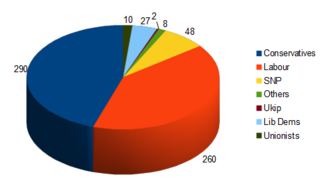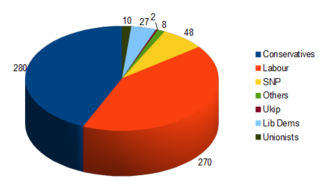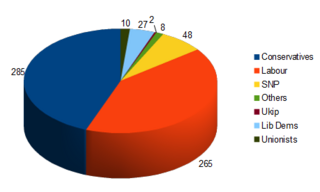Episode 16: The Balance of Power
John Lanchester
Time for a look at prospective election outcomes in close detail. The numbers haven’t moved much: if they were share prices, they would be described as ‘trading within a narrow range’. The realwinning line, as I argued in my last post, is 323. At the moment no party lookseven vaguely likely to get there alone. Instead, the bookies and the pollsters both have for some time had the Tories wobbling around somewhere in the range of 280 to 290 seats. Labour’s vote inScotland has collapsed, as everyone knows; if it hadn’t, they would have a clear lead. Instead they are wobbling around the 260 to 270 level.
With numbers like this, the other parties decide the next government. There’s a sense in which it doesn’t much matter how many seats the SNP win in Scotland, since Labour and SNP areboth anti-Tories: when it comes to the question of who’s next through the door of 10 Downing Street, 265 Labour and 45 SNP is in effect the same as 270 Labour and 40 SNP. Let’s give the SNP 48seats, because that’s what they were on in Newsnight’s latest projection last night. On the same basis the Lib Dems can have 27 seats. The Ulster Unionist parties have come to a deal tonot contest each other’s seats, so that will probably give them 10 between them. Say five for Sinn Féin, three for the SDLP, four for Plaid Cymru, Caroline Lucas holds Brighton for the Greens, Ukiphold one of their Tory-defected seats and pick up another (as per Newsnight). That makes the conveniently round number of 100 seats between the smaller parties, with Labour and the Toriesfighting over the other 550.
The crucial break point is between 290 and 280 Tory seats. The Tories will, you have to assume, be able to cut a deal with the Unionists. 290 plus 10 Unionists gives 300, at which point the 27 LibDems can put the Tories back in office either by voting with them or promising to abstain: 300 plus 27 is a winning 327. Labour plus all the others would be on 318.
The maths of 280 Tory seats are very different. Cut a deal with the Unionists, chuck in the Lib Dems, and the Tory alliance would still only be on 317. Lob on a couple of Ukip, wildly implausiblethough that multi-party alliance would be. They’re still four seats short of 323, and there doesn’t seem to be any way of getting there. Labour would have 270 seats to start with: give them the SNPand they’re one ahead of the Tory-Lib-Dem-Unionist mash-up, on 318. But they would have a lot more material to work with: Plaid, the SDLP and the Greens would give them eight seats and take them toa cosy, luxurious (by these standards) 326.
So the Tory numbers are 290 for government, 280 for opposition, with the Labour numbers being 270 and 260 respectively. These are useful figures to keep in mind when following the coverage.Newsnight currently has the projection as 279/270, which puts Miliband in Downing Street.
What about the Tory numbers in between 290 and 280 – the ones currently predicted by spread bettors, who have historically tended to be more accurate than pollsters? If you think the outcomes I’vealready discussed are unacceptably messy, look away now. 285 Tories plus 10 Unionists plus 27 Lib Dems is 322. Labour would be on 265: that plus SNP plus everybody else on the left would take themto 321. The two Ukip seats would mean that Farage’s party held the balance of power. Give the Tories one more seat: 286 Tories plus 10 plus 27 would be 323, the narrowest win. Give them 284: thatwould leave Labour with a chance of putting together a winning anti-Tory total of 324, but only with the help of Ukip. The same electoral outcome means the Tories too could make it to 323, but,again, only with the help of Ukip. The negotiations around all these possibilities would be gruesome.
Note that in all the scenarios outlined above, the Lib Dems have control over who occupies 10 Downing Street. Even with the Tories doing ten seats better than the best case and getting 300 seats,Cameron isn’t prime minister unless the Lib Dems say so. (If they chose not to do that, the Labour route to power would be 250 Labour seats plus 48 SNP plus 27 Lib Dems equals 325, almost certainlyvia minority government rather than coalition.) But it would surely be very difficult for the Lib Dems to exercise their kingmaking role in favour of Labour. If the Tories are ahead in both thepopular vote and the number of seats – which is the projection implied in all these numbers – it would be hard for the Lib Dems to jump the other way. Also, they’ve just kept the Tories in powerfor the last five years. In effect, they would be voting against their own record.
All true. The only way the Lib Dems could plausibly deny office to the Tories (on these numbers) is if they were able to establish a narrative about how the Tories’ plans for the next term areunconscionable. They would have to say things like, we know what the Tories are like in private, and what they really think; we know how far they want to go. One term was justifiable, but give themfive more years and they will destroy the welfare state. The national interest dictates that we have no choice except to kick them out of government.
If the Lib Dems were contemplating doing that, they might well start leaking stories about terrible things the Tories had thought about doing in the last Parliament. The stories might look a lotlike the one on the front of today’s Guardian: ‘Revealed: Tory plan to slash £8 bn benefits.’ In that scoop, Danny Alexander revealed ‘secret’ Tory plans to cut £8 billion in welfarespending, mainly from child benefit. Or they might set up a story like the one on the front of today’s Times, which says ‘Lib Dems to revolt over fresh pact with Tories’. First sentence:‘Nick Clegg will face huge resistance from within his own party if he tries to push through a second coalition deal with the Conservatives, according to Liberal Democrats at every level.’
I’m not saying the Lib Dems are definitely plotting to dump the Tories. If they were, though, this is exactly how they would be giving themselves the political space to do it.



Comments
-
30 April 2015
at
3:49pm
Joe Morison
says:
If they were planning to dump the Tories, why would Clegg so recently have ruled out coalition with Labour if it has to rely on the SNP in a vote of confidence? Clegg knows as well as any that it is almost certain that Miliband can only become PM with SNP support.
-
30 April 2015
at
4:22pm
wolfe-tone
says:
Now I wonder if a Tory , lib dem , Ulster unionist alliance scrapes in by 1 or 2 if Sinn Fein might just take their seats for a day to wreck it
-
3 May 2015
at
5:18pm
mototom
says:
@
wolfe-tone
Hey Wolfie, you've not been paying attention. Our correspondent addressed this question a few episodes ago.
-
30 April 2015
at
5:33pm
suetonius
says:
Thing is, 538, which tends to be very very accurate, has the Tories at 279 and Labor at 270, SNP at 48, LP at 27 and Unionists at 8. So the Tories would max out at 214, 9 short of even the low number. Labor + SNP is 318, so they need to scrape at least 5 more, Plaid Cymru 4 + Greens 1 does it.Not that I can see it matters, while Miliband is to the left of Blair, that's not really a useful yardstick, my dog is well to the left of Tony Blair.
-
3 May 2015
at
11:34am
Doomlord
says:
@
suetonius
Hello Suetonius, I hope you're right that 538 tends to be very accurate - but on what do you base the claim? US stuff? Or other analyses into Blighty?
-
3 May 2015
at
5:04pm
suetonius
says:
@
Doomlord
They got every state right in the last presidential election. If I remember right, they got all but one right in the election before that. You're right it's US stuff, but they're just good stats nerds, and I expect country won't affect that.
-
30 April 2015
at
8:15pm
streetsj
says:
Looking increasingly likely that there will be a second election soon. Who will be best in the intervening period? Do the Tories dare get rid of Cameron if the window is so small?
-
2 May 2015
at
10:56am
Sceptical2015
says:
I think J Lancaster is bang on the money in suggesting a tie-up between Labour & the Lib Dems, a possibility overlooked by the pundits elsewhere. I suspect that one of the biggest hints came when Danny Alexander revealed Lib Dems opposition within the Co-alition to Tory benefit cuts. Would he really have embarrassed the Tories if he were possibly going to work with them again? Clegg has a very weak grip on the leadership of the Lib Dems and it has even been suggested that he could lose his parliamentary seat. What then? Cable has done his worst from the outset to destabilise the Co-alition and makes no secret of his antipathy to the Tories. Besides, he wants to be Chancellor and he has more chance of achieving his ambition negotiating with Labour were the Lib Dems to form a government with them, or at least he would be number 2 to Balls. Then there is Tim Fallon. What if Clegg loses his seat, the Lib Dems re-form amidst the chaos with Farron emerging as leader? Added to which, there is the possibility that pundits have grossly underestimated the effect of changing demographics, even in the relatively short space of 5 years. Labour could put up a tree decoration as leader and their supporters would still vote Labour. The strident criticism Milliband receives from all sides is in reality a distraction and distorts the true picture. We'll all find out what the true situation is on Thursday!
Read moreMore likely is that today's story is part of the we-will-be-the-Tories'-conscience narrative. Clegg's a natural Conservative of the old school that was ousted by Thatcher, he feels at home with them in a way he never could with Labour.
Vote early, vote often!
Would love to know. Hope to hear from you.